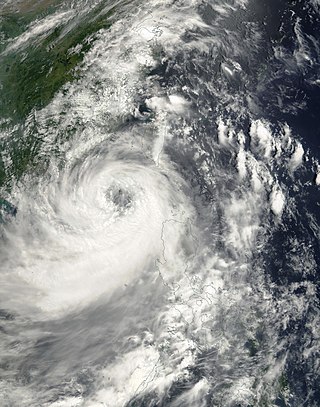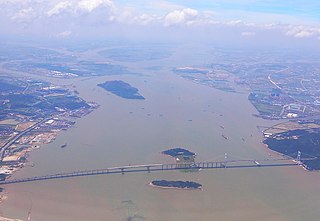Related Research Articles

Hurricane Mitch was the second-deadliest Atlantic hurricane on record, only after the Great Hurricane of 1780 which killed at least 22,000 people. Hurricane Mitch caused 11,374 fatalities in Central America in 1998, including approximately 7,000 in Honduras and 3,800 in Nicaragua due to cataclysmic flooding from the slow motion of the storm. It was the deadliest hurricane in Central American history, surpassing Hurricane Fifi–Orlene, which killed slightly fewer people in that area in 1974.

Typhoon Imbudo, known in the Philippines as Typhoon Harurot, was a powerful typhoon that struck the Philippines and southern China in July 2003. The seventh named storm and fourth typhoon of the season, Imbudo formed on July 15 to the east of the Philippines. The storm moved generally west-northward for much of its duration due to a ridge to the north. Favorable conditions allowed Imbudo to intensify, gradually at first before undergoing rapid deepening on July 19. After reaching typhoon status, Imbudo strengthened further to peak 10–minute sustained winds of 165 km/h (103 mph) on July 20. The typhoon made landfall on northern Luzon near peak intensity on July 22, but quickly weakened over land. Once in the South China Sea, Imbudo re-intensified slightly before making its final landfall in southern China near Yangjiang on July 24, dissipating the next day.

The 1998 China floods (1998年中国洪水) lasted from middle of June to the beginning of September 1998 in China at the Yangtze River as well as the Nen River, Songhua River and the Pearl River.

Typhoon Matsa, known in the Philippines as Typhoon Gorio, was the second of eight Pacific tropical cyclones to make landfall on China during the 2005 Pacific typhoon season. The ninth tropical storm and fifth typhoon of the season, Matsa developed on July 30 to the east of the Philippines. Matsa intensified as it tracked northwestward, and attained peak 10-minute sustained winds of 150 km/h (93 mph) near Taiwan before weakening and striking the Chinese province of Zhejiang on August 5. The system continued northward into the Yellow Sea, and on August 7 Matsa became extratropical after again moving ashore along the Liaodong Peninsula. Matsa is a Laotian name for a lady fish.

The 2010 China drought and dust storms were a series of severe droughts during the spring of 2010 that affected Yunnan, Guizhou, Guangxi, Sichuan, Shanxi, Henan, Shaanxi, Chongqing, Hebei and Gansu in the People's Republic of China as well as parts of Southeast Asia including Vietnam and Thailand, and dust storms in March and April that affected much of East Asia. The drought has been referred to as the worst in a century in southwestern China.

The 2010 China floods began in early May 2010. Three hundred and ninety-two people died, and a further 232 people were reported missing as of June 30, 2010, including 57 people in a landslide in Guizhou. Fifty-three of the deaths occurred from the flooding and landslides between May 31 and June 3, and 266 deaths occurred between June 13 and June 29. Four hundred and twenty four people were killed by the end of June, including 42 from the Guizhou landslide; 277 more were killed and 147 were missing in the first two weeks of July, bringing the death toll as of August 5 to 1,072. A landslide in early August in Gansu killed at least 1,471 people and left 294 missing. In total, the flooding and landslides killed at least 3,185 people in China by August 31. More than 230 million people in 28 provinces, municipalities, and regions, especially the southern and central provinces and regions of Zhejiang, Fujian, Jiangxi, Hubei, Hunan, Guangdong, Guangxi, Chongqing Municipality, Gansu, Sichuan, and Guizhou, and the northeastern province of Jilin were affected, while at least 4.66 million people were evacuated because of the risk of flooding and landslides in the latter half of June. By early August, over 12 million people were evacuated, and that number rose to 15.2 million by August 31.
The 2011 China floods were a series of floods from June to September 2011 that occurred in central and southern parts of the People's Republic of China. They were caused by heavy rain that inundated portions of 12 provinces, leaving other provinces still suffering a prolonged drought, and with direct economic losses of nearly US$6.5 billion.

Typhoon Gordon, known in the Philippines as Typhoon Goring, was a powerful tropical cyclone that caused widespread damage and loss of life in the Philippines and Southern China in July 1989. Gordon developed into a tropical depression near the Northern Mariana Islands on July 9 and quickly intensified as it tracked west-southwestward. On July 13, the storm attained typhoon status and subsequently underwent a period of rapid intensification. By July 15, the storm attained its peak strength as a Category 5 equivalent super typhoon with winds estimated at 260 km/h (160 mph). After striking the northern Philippines, Gordon moved through the South China Sea and slowly weakened. On July 18, the storm made landfall in southern China and was last noted the following day as it dissipated over land.

The July 2012 Beijing flood was part of a series of 2012 flooding events across China that began in late spring of 2012 and continued during the summer. In July, the areas of southwestern China, including Guangxi Zhuang Autonomous Region, and northeastern China including Beijing, Hubei and Liaoning were worst-affected.

In July 2013, much of southwest China experienced heavy rainfall that led to widespread flooding. Sichuan was the hardest hit. At least 73 people were killed as a result of the flooding, with 180 people missing. An estimated 6 million lives were disrupted by the floods.

Typhoon Krovanh, known in the Philippines as Typhoon Niña, was a moderate tropical cyclone that caused a swath of damage stretching from the Philippines to Vietnam in August 2003. The fifteenth named storm and sixth typhoon in the western Pacific that year, Krovanh originated from a tropical disturbance within the monsoon trough on August 13. Despite rather favorable conditions, the initial tropical depression did not intensify significantly and degenerated into a remnant low on August 18. However, these remnants were able to reorganize and the system was reclassified as a tropical cyclone a day later. Intensification was rather rapid upon the storm's reformation – the depression reached tropical storm status on August 20 and then typhoon intensity two days later. Shortly after, Krovanh made landfall on Luzon at peak intensity with winds of 120 km/h (75 mph). The typhoon emerged into the South China Sea as a much weaker tropical storm, though it was able to restrengthen over warm waters. Once again at typhoon intensity, Krovanh clipped Haiyan before moving over the Leizhou Peninsula on its way to a final landfall near Cẩm Phả, Vietnam on August 25. Quick weakening due to land interaction occurred as Krovanh moved across northern Vietnam, where the storm met its demise the following day.

Severe Tropical Storm Utor, known in the Philippines as Typhoon Feria, was a large and deadly system that caused heavy rains and landslides throughout the Philippines, Taiwan, and China. The eighth tropical depression and fourth named storm of the 2001 Pacific typhoon season, Utor formed on July 1 and intensified into a tropical storm shortly after. Utor was upgraded to a typhoon by the JTWC on July 3, and a day later, Utor was estimated to have peaked with 10-min winds of 110 km/h (70 mph), with the JTWC estimating 1-min winds of 150 km/h (95 mph). After passing just north of Luzon, Utor began to weaken, before making landfall on the district of Dapeng as a minimal typhoon. Utor caused 203 deaths, of which 168 were in the Philippines, 23 were in the province of Guangdong, 10 were in the province of Guangxi, and 2 were in Taiwan. Total damages from the storm amounted to $2.78 billion.
This is a list of notable recorded floods that have occurred in India. Floods are the most common natural disaster in India. The heaviest southwest, the Brahmaputra, and other rivers to distend their banks, often flooding surrounding areas.

Guangxi, officially the Guangxi Zhuang Autonomous Region, is an autonomous region of the People's Republic of China, located in South China and bordering Vietnam and the Gulf of Tonkin. Formerly a province, Guangxi became an autonomous region in 1958. Its current capital is Nanning.

The 2015 South India floods resulted from heavy rainfall generated by the annual northeast monsoon in November–December 2015. They affected the Coromandel Coast region of the South Indian states of Tamil Nadu and Andhra Pradesh. More than 500 people were killed and over 1.8 million people were displaced. With estimates of damages and losses ranging from nearly ₹200 billion (US$3 billion) to over ₹1 trillion (US$13 billion), the floods were the costliest to have occurred in 2015, and were among the costliest natural disasters of the year.
In mid-June 2016, severe weather such as heavy rainfall, thunderstorms and hail began across southern China, triggering deadly floods. Over the following month, additional rain events exacerbated flooding and affected more of the country. Areas along the Yangtze River and Huai River have been particularly hard-hit. An estimated 32 million people across 26 provinces were affected and more than 200 people were killed. 280,000 hectares of cropland was destroyed, with state damage estimates of around US$5.73 billion. According to Aon Benfield, the damage estimate has reached US$22 billion. Flooding of this magnitude was last seen in the country in 1998. The floods destroyed over 23,600 houses and left 3,600 refugees homeless.

Typhoon Sarika, known in the Philippines as Typhoon Karen, was a powerful tropical cyclone which affected the Philippines, South China, and Vietnam in mid-October 2016. The twenty-first named storm and the tenth typhoon of the annual Pacific typhoon season, Sarika developed from a tropical disturbance east of the Philippines on October 13. The system steadily strengthened as it traveled westwards, becoming a tropical storm later that day and then a typhoon on October 15. Rapid intensification commenced as Sarika turned to the west-northwest towards Luzon, reaching its peak intensity just before making landfall in Aurora early on October 16. Sarika weakened significantly as it crossed land, emerging over the South China Sea as a minimal typhoon, then weakening further to a severe tropical storm on October 17. Sarika maintained its strength for the rest of the day and made landfall in Hainan province in China on October 18. Turning to the northwest, Sarika weakened quickly as it emerged into the Gulf of Tonkin, before moving onshore once again in Guangxi province on October 19. The system dissipated shortly after.

The Pearl River Basin is one of China's largest river basins, located in South China within total area approximately 453,700 square kilometers in Guangdong, Guangxi, Guizhou, Yunnan, Hunan, Jiangxi and Fujian provinces, and part of Northeastern Vietnam.

Several floods struck China starting in July 2023, most of them caused by heavy rainfalls in different areas. The most notable floods were the 2023 Beijing-Tianjin-Hebei Heavy rain and Northeast china heavy rain, which left at least 81 dead and 34 missing.
References
- ↑ Preliminary Appeal, Assistance to Flood Affected – CHN121
- ↑ Beijing chaos after record floods in Chinese capital, BBC News , July 23, 2012
- ↑ China’s ‘sponge cities’ are not built for extreme flood events, Bloomberg, August 3, 2023